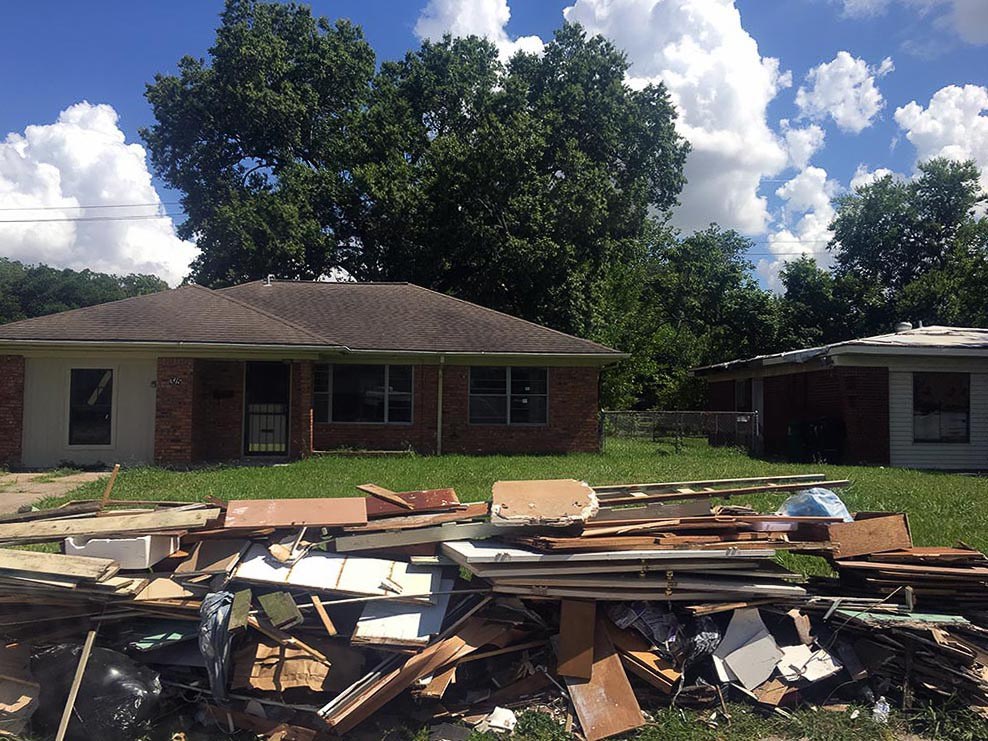This interview was conducted and originally published by the Barcelona Laboratory for Urban Environmental Justice and Sustainability. Below is a lightly edited excerpt of the interview.
Nearly a year after Hurricane Harvey and with hurricane season again underway, is the city of Houston building back what existed — its inadequacies and inequities revealed in the floodwaters — or is it building back better? On June 14, our lab director Isabelle Anguelovski participated in the panel Designing, Planning and Paying for Resilience at Rice University Kinder Institute for Urban Research, where she and other leading experts discussed flood mitigation strategies such as low impact design, green infrastructure and urban-scale greenspace preservation, and how they interact with a community’s broader planning efforts. In particular, Anguelovski focused on issues of social equity related to these processes, how they affect residents and how communities are organizing to prevent and fight the displacement that often occurs with green gentrification. In the interview below, Anguelovksi shares her insights from the panel and our lab’s ongoing research on this topic.
What kind of reconstruction and greening initiatives are we seeing post-Harvey in Houston that are raising social equity concerns?
It seems to me that one of the most controversial green resilience planning initiatives post-Harvey has to do with the buyout program. Buyout programs are sponsored by the Harris County Flood Control District and financed by federal grants as well as local funds. They consist of buying out houses and other types of properties to address potential flood damages. The land on which those properties are located is then often turned into green infrastructure and/or green spaces. From the meetings and discussions I was part of, residents in African-American and lower-income communities showed concerns about this approach because of displacement and relocation issues and their fear of not being able to afford anything in a nearby community with the money they’d receive, even if the buyout program would pay them a fair price for their house. Those fears also stem from long-term trauma related to housing segregation and discrimination. Lastly, residents also seemed concerned about the loss of community ties as a result of this displacement.
How do these programs affect residents, more specifically?
A lot of these fears seem to be manifested in neighborhoods like Independence Heights and Kashmere Gardens, the former being a historic and still mostly African American neighborhood. Residents claim that elevating homes would be “resilient enough” and cost less than a buyout, but this “preservation” approach is not a commonly used strategy in Houston, where a more common approach has been tearing properties down, replacing them, and/or greening. Also, many lower-income flood victims don’t have the funds to rebuild or elevate their homes and FEMA won’t insure them, which means that many of them leave their neighborhood. So, there are new forms of insecurity in those neighborhoods linked directly or indirectly to Harvey, infrastructure planning and green resilience.
What is the role of local real estate developers in this process?
When residents walk away and the land is not part of the buyout program, developers come in quickly and flip the lots. This can be a goldmine for them. Many even seem to be encouraging residents to sell and/or leave their property to be able to access land considered to be in a prime location for their investment strategy.
Neighborhoods like Independence Heights will also likely have a substantial proportion of its edges taken over by the expansion of highway I-45, along which there will likely also be new townhouse developments. Residents perceive this as a move to remake their neighborhood for upper income residents whose new homes will be the gate of entry to the community and who will have direct access to new highway ramps and be very close to the business district and Midtown. All of this process means that the historic black commercial corridor—and the jobs that go with it—will be torn down, which is of course creating deep concerns of displacement for residents.
Displacement is also social and cultural because developers and other investors, like Whole Foods, contemplated using alternative names for the neighborhood like “Garden Oaks” as they announced new businesses or projects, and thereby erasing its historic African American identity and significance. Activists don’t often have the power to respond to developers. This was basically the bottom line of people’s analysis.
Read the full interview here.

